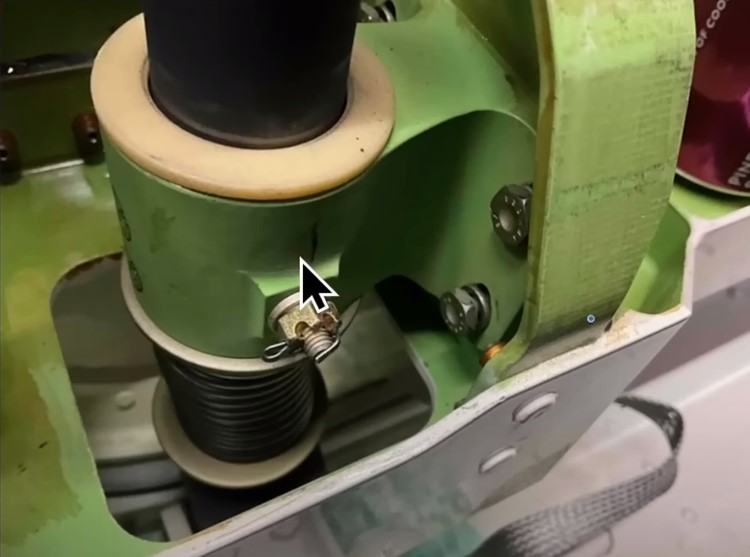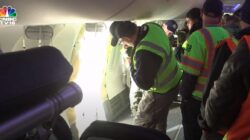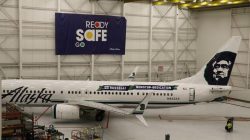The title of this post may seem like a pun but this may have absolutely everything to do with nuts and bolts. This post is part 2 covering the door plug blowout aboard Alaska Airlines flight 1282. If you missed part 1 where I talk about the basics of the plug door, you can read it here. Part 3 can be found here. I reviewed the evaluation of two experienced pilots to put this story together.
What Went Right
Before talking about the nuts and bolts story, there are a lot of factors that went right. It is important to know the critical factors that kept this event from becoming a fatal accident. The pilots of this flight did a great job when faced with total chaos and successfully landing the aircraft.
This event took place at an altitude of less than 16,000 feet. This is important because the pressure differential at 16,000 is much less than at a cruising altitude of over 36,000 feet. Had the blowout happened at cruising altitude, if would have done a lot of damage to the aircraft and there may have been some unbelted passengers sucked out of the plane. The fuselage of flight 1282 does not show any external damage. The door plug that was found on the ground had fallen three miles to the ground and is not deformed. There were no passengers seated at 27A and 27B which are the closest seats to plug door.
The decompression did manage to blow the cockpit door open. This blew the radio headsets of the pilots and the quick reference handbook (QRH) out of the copilot’s hands. This is where training comes in. Without an emergency checklist along with descent and landing checklists, these pilots relied on “memory items” to get the plane on the ground. Memory items are essential functions that pilots must know from memory. Flying a plane comes down to three areas:
- Aviate,
- Navigate and
- Communicate.
Since the aircraft had just taken off, it landed just 20 minutes after the decompression event. Here is the radio traffic between Alaska 1282 and Seattle Center (ATC). After declaring an inflight emergency and getting altitude and vectors back to PDX Runway 28L, the pilots are handed off to Portland Approach and then Portland Tower with immediate clearance to land on Runway 28L. Initially, the copilot sounds muffled on the radio because she is wearing her oxygen mask.
The incident did not damage the aircraft which would make it difficult or impossible to control. They did not have a full fuel load so they were within the maximum landing weight allowing them to make two left turns and set up for final approach.
The Attention Turns To The Bolts
The door plug was found on the ground along with two cell phones and a headrest from one of the seats. There are four bolts and nuts that secure the door plug to the airframe. None have been found. This could mean that bolts were loose and not installed correctly or some bolts were not installed at all.
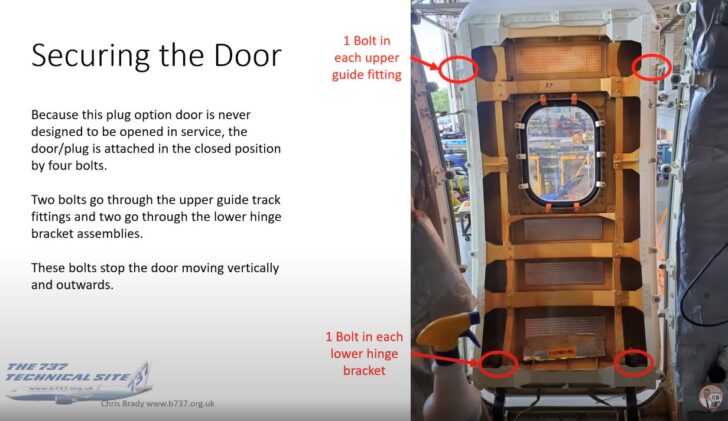
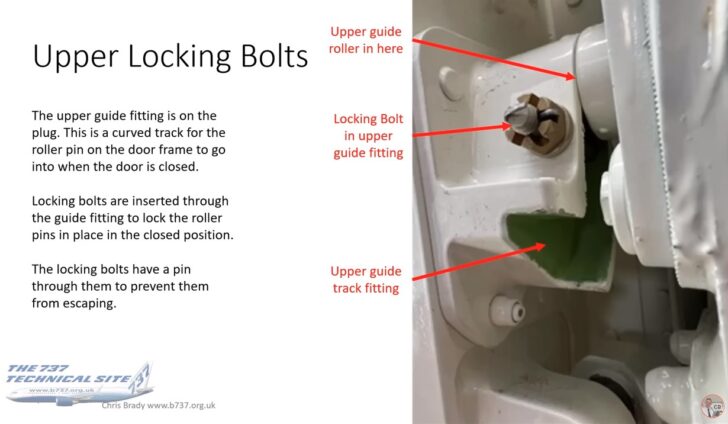
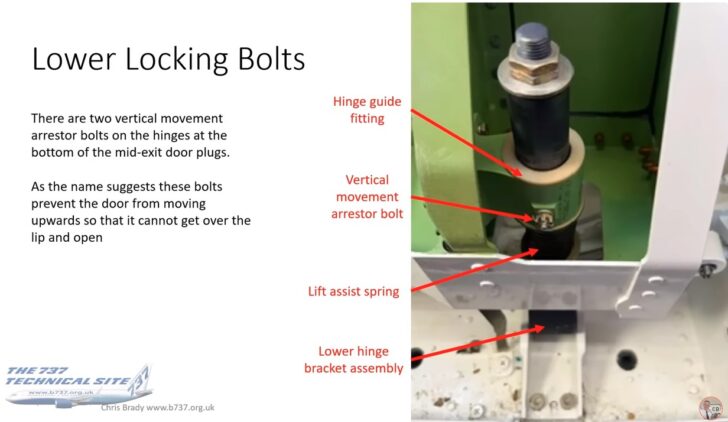
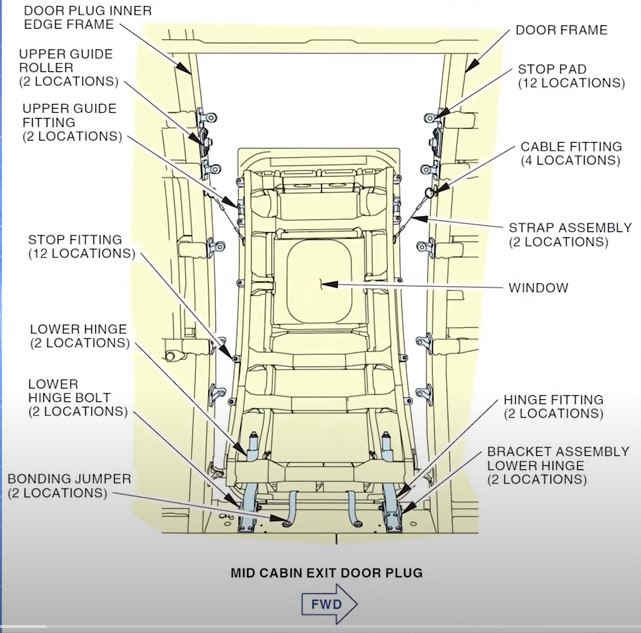
There are two bolts with castle nuts and cotter pins that secure the top of the plug to the plug track. Castle nuts have notches that allow a cotter pin to go through the nut and through a hole in the bolt. This method keeps the nut from working itself loose. The bottom of the door plug is also secured by a bolt and castle nut on each side that is part of a bracket connected to the airframe. There is a door seal to maintain pressurization. The doors aircraft use differential air pressure to keep them in place thus creating a “plug”. The higher air pressure inside the aircraft presses the plug or door into the fuselage. Inspection on this aircraft found that one of the bottom brackets was also missing. The bottom of the plug is spring-loaded (see below). If the top of the plug slides down the track, the plug will spring up and fall off the airplane. If that is the case, it could be that the top bolts were missing. This would also be the reason that there is no damage to either the fuselage or the plug.
A likely scenario is that the top bolts were missing. Movement of the door vertically may have occurred during turbulence. Then upward movement caused the springs to push out the bottom of the plug where it left the aircraft and fell to the ground. I need to mention that the investigation is still ongoing but this is the leading theory as to what happened.
During the second-day briefing by the NTSB, a reporter asked NTSB Chair Jennifer Homendy this question – “If there were loose bolts at fault, what about the rest of the bolts in the airplane”. She never answered that part of the reporter’s question.
The FAA Response
Initially, the FAA approved and inspection and bolt tightening if needed. This process takes five technicians about four hours to complete as they have to remove two rows of seats and the interior panel of the plug door. When United Airlines found five aircraft with loose bolts, the FAA reversed course and continued grounding the aircraft. Yesterday, there was a meeting of the minds between Boeing and the FAA which finally approved an inspection plan. The grounding have forced United Airlines to cancel of 200 flights per day and another 150 at Alaska Airlines. Turkish Airlines and Lion Air have also grounded their 737 MAX9 aircraft.
Boeing said: “Our teams have been working diligently – with thorough FAA review – to provide comprehensive, technical instructions to operators for the required inspections, This morning, our team issued the instructions via a multi-operator message.”
In its January 8 update, the FAA said that affected Max 9s “will remain grounded until operators complete enhanced inspections, which include both left and right cabin door exit plugs, door components and fasteners. Operators must also complete corrective action requirements based on findings from the inspections prior to bringing any aircraft back into service.”
There Are Red Flags
The fuselage structure is made at Spirit AeroSystems in Witchita, KS and then transported to Renton, WA by train.
At Renton, WA, Boeing does the final assembly of mating the wings, elevators, tail, engines and landing gear. After the exterior is put together, Boeing then assembles the interiors. The plug doors are removed to load interior components. I am not going to blame Boeing at this time as the NTSB is still investigating this incident.
Boeing is currently obtaining FAA approval for two other 737 MAX variants, the 737 MAX7 and 737 MAX10. This incident will certainly set the approval process back.
The Reaction At Boeing
As you can imagine, this is another black eye for the 737 MAX program. Since 2019, the 737 MAX airlines have had issues with:
- MCAS, the software that helps the pilots maintain control of the plane. Two 737 MAX aircraft crashed and the aircraft were grounded while MCAS was reworked,
- Engine nacelle problems. The nacelles are the structures that surround the engines,
- Loose rudder bolts and
- The plug door leaving the aircraft.
Is there a safety culture problem at Boeing? Are there enough inspectors to validate the assembly of aircraft? On Tuesday, Boeing CEO David Calhoun addressed Boeing employees over the Alaska 1282 incident acknowledging the Company’s mistake.
“We’re going to approach this number one acknowledging our mistake,” Calhoun told staff, according to a video of the meeting provided to CNN by Boeing. “We’re going to approach it with 100% and complete transparency every step of the way. We are going to work with the NTSB who is investigating the accident itself to find out what the cause is.”
Calhoun went on to say that Mike Delaney, Boeing’s Chief Aerospace Safety Officer is now in charge of the 737 MAX program.
Final Thoughts
This is not good. This is the fourth serious problem with the Boeing 737 MAX program. The 737 MAX is the current offering of an airliner that started flying commercially in 1967. Boeing can’t afford to have any more incidents or accidents with the 737 MAX. The aircraft flown on Alaska Airlines flight 1282 was just delivered new to Alaska on October 31, 2023. I hope that Mike Delaney will ensure that the safety culture at Boeing is at an acceptable level.


